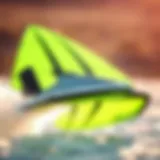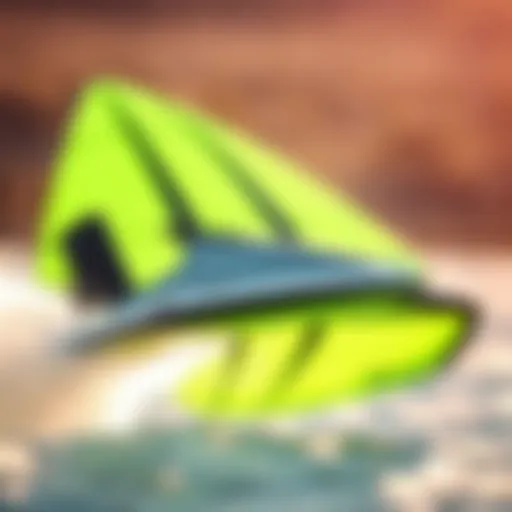Discover Texel: A Kiteboarding Paradise in the Netherlands
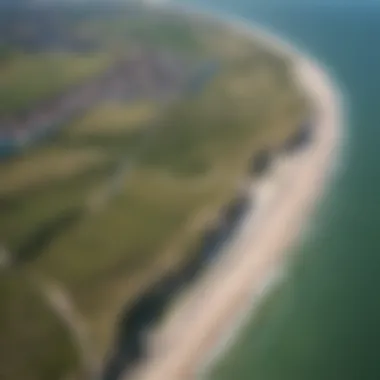

Intro
Texel stands out as the largest of the Dutch Wadden Islands, a true gem for those who live and breathe kiteboarding. The island's unique geography, with vast beaches and consistent winds, creates an ideal backdrop for both seasoned pros and newbies alike. There’s something magical about the open waters and wide skies that beckon kiteboarding enthusiasts from near and far.
Kiteboarding here is not just about the thrill; it's also about the community. Local spots buzz with laughter, cheers, and the unmistakable sound of kites whipping through the air. Clubs and schools offer a wealth of knowledge and camaraderie that can enhance the entire experience. Whether you're navigating through the learning curve or looking to refine your techniques, Texel is where your kiteboarding journey flourishes.
The ethos of kiteboarding on Texel transcends the mere act of riding the wind. It’s about mastering the art of balance, embracing the elements, and celebrating the spirit of adventure. This comprehensive guide will take a closer look at what makes Texel a kiteboarding haven, diving deep into gear insights, safety practices, and the finer points of kiteboarding culture that define this extraordinary destination.
Gear Insights
Latest Gear Reviews
For kiteboarders, investing in the right gear is just as critical as learning how to navigate the waves. When you hit the salty water, having reliable equipment can be the difference between a fantastic day and a frustrating one.
In recent reviews, several brands have emerged as leaders in the kiteboarding scene. The North Kiteboarding Reach, for instance, is praised for its versatility. It adapts to a range of wind conditions, making it suitable for both flat water and choppy seas. Riders have noted how effortlessly it launches, allowing for a smoother ride.
Another standout is the Duotone Neo, which has received accolades for its performance in lighter winds. Riders appreciate how it maintains lift while providing the stability needed for confident maneuvers, especially beneficial for those trying out new tricks. Always consider your skill level and the conditions you'll face while choosing your kite.
Essential Gear for Beginners
If you’re just starting in kiteboarding, it can be a tricky process choosing the right gear, but it's easier than you think. Here’s what you’ll need to kick off your kiteboarding adventure:
- Kite: Opt for a size that matches your weight and the typical wind conditions you'll encounter. A good beginner kite is the Liquid Force Solo, known for its forgiving nature and stability.
- Board: Choose a board that matches your experience level. Freeride boards are generally wider and more stable, such as the Naish Monarch, making them ideal for newcomers.
- Harness: A comfortable and secure harness is essential. Look for a waist harness that fits snugly; models like the Mystic Warrior are popular choices among beginners.
- Wetsuit: Depending on the season, an appropriate wetsuit can keep you warm. Investing in a good one, such as the O'Neill Hyperfreak, is wise for added comfort.
Investing in the right equipment sets you up for success and ensures you enjoy the exhilarating world of kiteboarding for years to come.
Prolusion to Texel and Kiteboarding
Texel is much more than just a dot on the map; it’s the largest of the Dutch Wadden Islands and a true treasure for kiteboarding enthusiasts. This unique island, with its diverse landscapes and breezy coastal conditions, has positioned itself as a premier kiteboarding destination in the Netherlands. As you dive deeper into this guide, you will uncover the reasons behind Texel's magnetic pull for both novice kiteboarders and seasoned pros alike.
Geographic Overview of Texel
Nestled in the North Sea, Texel spans approximately 40 kilometers long and is characterized by a combination of lush green meadows, rolling dunes, and striking sandy beaches. The island’s varied ecosystem enhances the kiteboarding experience, providing different wind patterns and wave conditions.
Imagine setting out from De Koog, where you can catch the refreshing North Sea breeze, or perhaps hitting up the expansive beach at Oudeschild—each locale brings its own flavor to the sport. The geography isn’t just a backdrop; it shapes the very essence of kiteboarding on the island, offering riders everything from flat water to choppy surf. With shallow waters on one side and more challenging waves on the other, Texel caters to all skill levels, ensuring everyone can find their perfect spot.
The Appeal of Kiteboarding in Texel
What makes kiteboarding in Texel particularly appealing? Well, it’s a mixture of factors that create an ideal playground for thrill-seekers. For starters, the wind conditions are often just right, blowing consistently enough to keep the kites flying high without being too overpowering for inexperienced riders. Combine this with a landscape that feels untouched and pristine, and you’ve got an unparalleled experience waiting to unfold.
Moreover, the local vibe adds another layer of charm. The Texel kiteboarding community is welcoming and vibrant. You’ll find instructors ready to help you conquer your fears or master new tricks and an array of events showcasing both competitive spirit and camaraderie.
As you ride along the shores, the energy of fellow kiteboarders is palpable, creating an atmosphere that’s both electric and friendly. Riding alongside others creates a unique sense of belonging, allowing for connections that go beyond just the sport itself.
"Kiteboarding on Texel isn’t just about the wind and water; it’s about finding your place among friends while chasing the thrill of the next ride."
Texel is not just a physical location but an experiential one, offering you a lifestyle steeped in adventure. Every gust of wind brings new possibilities, from mastering the basics to performing exhilarating tricks. In delving deeper into this kiteboarding haven, you’ll discover how its unique aspects cater to enthusiasts, novices, and everyone in-between.
Understanding the Local Climate
Grasping the local climate is essential for kiteboarders considering Texel as their playground. This island offers conditions that can transform a thrilling ride into a challenging endeavor. Understanding the climate lays the foundation for choosing the right time for your adventure and ensures safety while enjoying the waves. It can also dictate what gear you should be packing and how to prepare for the elements.
Weather Patterns Throughout the Year
Texel experiences a temperate maritime climate. The interaction between the North Sea and the island’s geography creates unique weather patterns that are particularly significant for kiteboarders. In winter, temperatures can drop, often hovering around zero degrees Celsius. It might not seem ideal, but some seasoned kiteboarders relish the chill, as winter winds can be potent and less crowded.
Spring arrives slowly, and temperatures gradually climb to a comfortable range. By March, it’s not unusual to see kiteboarders returning to the shores, hoping to catch those crisp breezes. The strongest winds typically start around April, creating opportunities for exciting rides as the island shakes off the winter chill.
As for summer, this season has a warmer vibe, with temperatures frequently climbing to about twenty degrees, sometimes even more. While many flock to the area for beach time, kiteboarding does not see a significant drop in demand. However, factors like boat traffic and a more challenging wind pattern can require a sharper eye and more skill for the rider.
Fall heralds unique conditions. As summer fade, the ever-present winds return, some might say, stronger than before. However, fluctuations in weather can be unpredictable this time of year, and kiteboarders must stay alert to changes, possibly enjoying the quiet beaches as tourists dwindle.
"Understanding Texel's weather patterns means knowing when to hit the water and when to pack it away!"
Optimal Kiteboarding Seasons
The prime kiteboarding seasons on Texel encompass spring to early autumn. Spring is particularly rewarding, with consistent winds and fewer beachgoers. If you’re eager to practice your skills without the distraction of a bustling crowd, this is your sweet spot.
- March to May: As aforementioned, the winds begin to peak. As you ride, you can feel a delightful sense of freedom—like you’re carving through the air, unencumbered by the clamor of summer visitors.
- June to August: This is peak season; the beaches are lively, events often abound, and there’s a buzz in the air. Winds can vary from gentle breezes ideal for beginners in the mornings to powerful gusts in the afternoon. Pay attention to forecasts—timing your sessions right means the difference between a mediocre ride and a mind-blowing session.
- September to October: Fall ushers in incredible conditions, as the warm summer waters still linger but winds begin to pick up again. You get a hint of solitude on the beaches, and keen kiteboarders know the value of this hidden gem of a time.
For novice riders, adjusting to conditions is half the battle; thus, selecting the right season is paramount. Being attuned to Texel’s climate translates to maximizing fun while ensuring safety out on the water.
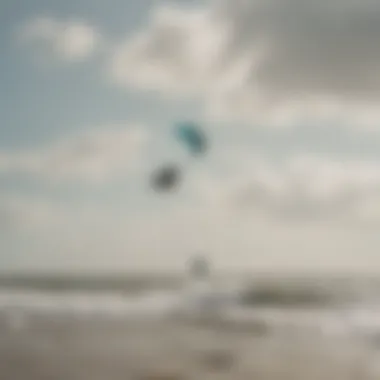

Kiteboarding Spots on Texel
Texel offers a variety of kiteboarding spots, making it a premier choice for enthusiasts. The distinct geographical features and favorable winds provide an ideal environment for kiteboarding. Whether you’re new to the sport or an experienced rider, understanding these spots is essential to maximize your experience.
Popular Beaches for Kiteboarding
Texel’s beaches are nothing short of a kiteboarding paradise. One of the standout locations is Oudeschild. Its expansive shoreline combined with strong, steady winds makes it a go-to spot for many riders. The beach hosts regular events, which can be a great way to meet locals and other enthusiasts.
Another notable spot is De Slufter, known for its natural beauty and less crowded environment. This beach provides ample space and a unique experience for practicing tricks and techniques without the distraction of heavy foot traffic. However, keep in mind that the conditions at De Slufter can be more challenging due to shifting winds, thus making it a good fit for those with some experience under their belts.
Additionally, Ecomare beach is popular among families who also kiteboard. It offers smooth waters and a welcoming vibe, making it friendly for beginners. Here, you can often find rentals and instructors ready to give you the inside scoop on local conditions.
The variety of beaches on Texel caters to all skill levels, allowing kiteboarders to choose a spot that matches their proficiency and preferred conditions. Emphasizing the importance of location is crucial; some areas experience more wind, while others provide steady waves. Ultimately, having knowledge about the beaches prepares you well, ensuring a safe and enjoyable experience.
Hidden Gems for Advanced Riders
For those who consider themselves adept at kiteboarding, Texel hides some treasures that are less frequented but intensely rewarding. Polderbaken is a prime example; this spot is loved by advanced kiteboarders due to its challenging conditions and dynamic water surface. Here, you’ll find a small community of skilled riders pushing their limits, perfecting tricks, and sharing techniques, making it an open school of kiteboarding.
Then there's the Rijkaard, a lesser-known spot that requires some navigation to access. It’s worth the effort—its isolated waves provide thrilling opportunities for high jumps and sharp turns. Experienced riders benefit from the solitude, enabling them to focus entirely on their skills without interruptions.
Texel has something for every kiteboarder, unlocking the door to exhilaration and growth on the water.
Both Polderbaken and Rijkaard demand respect for the sea. Always pay attention to the weather conditions and be mindful of any potential hazards. Advanced riders should consider forming groups when venturing to these hidden spots to ensure safety and support. Gathering intel from local riders can also enhance your experience at these locations, as they may offer insights not available in guides or forums.
In summary, kiteboarding spots on Texel present a blend of accessibility for beginners and exhilarating challenges for experts. This makes the island not just a destination but a canvas for personal evolution in one’s kiteboarding journey.
Essential Gear for Kiteboarding
When it comes to kiteboarding, the right gear can make or break your experience on the water. It's not just about looking good; utilizing the appropriate equipment enhances your safety, comfort, and performance. In this section, we’ll delve into the essentials every kiteboarder should have to ensure an enjoyable time on Texel's windswept beaches.
Choosing the Right Kite
Selecting the right kite is paramount. The market is brimming with various kite types, sizes, and designs, each serving a unique purpose. Generally, kites can be split into two categories: C-kites and bow kites. C-kites offer responsive performance, making them suitable for advanced tricks and maneuvers. Conversely, bow kites are renowned for their stability and ease of use, which appeal to beginners.
- Size Matters: The size of the kite directly correlates with wind conditions. In lighter winds, larger kites, around 12 to 14 meters, work best. During strong winds, a kite between 7 and 9 meters is usually optimal. It’s essential to evaluate wind forecasts before choosing your gear to match conditions effectively.
- Personal Preference: Think about your skill level and the style of riding you enjoy. If you fancy freestyle or wave riding, you might lean towards specific models favored by the pros. Test different options when you can — after all, what feels right for one person might not for another.
Harnesses: Types and Recommendations
Your harness acts as the second link in your rig, quite literally helping you hold onto the kite. There are two primary styles to consider: waist harnesses and seat harnesses.
- Waist Harnesses: These provide more freedom of movement and are typically favored by seasoned kiteboarders. They sit higher on the body and are connected to the kite via a spreader bar, allowing for maximum maneuverability.
- Seat Harnesses: Generally preferred by beginners as they offer better support and keep you in a stable position, cinching snug around the hips and thighs.
When selecting a harness, ensure it fits comfortably. Look for something that doesn’t ride up or chafe your skin too much. High-quality brands often provide adjustable straps, which is a bonus for a snug fit.
Importance of Safety Equipment
Safety should never be an afterthought in kiteboarding. The thrill of riding the waves and mastering your skills comes with inherent risks. Thus, investing in proper safety gear is not just advisable, it’s necessary.
- Impact Vest: This is crucial, especially for those who enjoy freestyle tricks. The vest not only cushions you from falls but also protects against potential hard hits.
- Helmet: Protecting your head is paramount. A well-fitted helmet designed for water sports can shield against impacts from the kite or other obstacles in the water.
- Leashes: A safety leash that connects the kite to the rider will prevent runaway kites from soaring off into the distance, potentially causing havoc.
Every kiteboarder, regardless of skill level, should prioritize safety. Proper gear doesn’t only protect you — it provides peace of mind, allowing you to focus on flying high and catching those epic waves.
In summary, kites, harnesses, and safety equipment are the backbone of any kiteboarder’s setup. Understanding the nuances of each type and investing in quality gear prepares you not just for the thrill of kiteboarding but enhances your overall experience on the stunning waters surrounding Texel.
Safety Considerations in Kiteboarding
Kiteboarding, while exhilarating, demands a solid grounding in safety practices. Far from being mere precautions, these safety considerations form the backbone of a secure and enjoyable kiteboarding experience. Whether you’re a novice trying your hand at catching the wind for the first time, or an expert rider pushing the boundaries of freestyle tricks, understanding safety is paramount. The thrill of gliding over the water coupled with soaring through the air should never come at the cost of personal safety.
Understanding Wind Conditions
When it comes to kiteboarding, wind is your best friend and also your most formidable foe. A comprehensive grasp of wind conditions is an absolute necessity. Kiteboarding should only ever be performed in conditions conducive to safe riding. Factors such as wind direction, speed, and gusts can change in the blink of an eye, impacting your ride dramatically.
- Wind Speed: Generally, wind speeds of 12 to 25 knots are ideal for most riders. >"If the winds are too light, you won’t have enough power to ride; if they are too strong, you risk losing control."
- Gusts: Gaining an understanding of gusty winds is crucial. Gusts can unpredictably spike or drop, so it's wise to always keep an eye on the horizon. Employing a kite equipped with a bar that has adjustable settings allows you to minimize tension when you’ve suddenly hit a fierce gust, affording more control.
- Wind Direction: Knowing the wind direction can make or break your kiteboarding session. For instance, head-on winds are often not the best for launching, while side-on winds can give more space to maneuver. A wind that blows directly onshore might seem appealing, but it can lead to tricky conditions as it pushes you back toward land.
By mastering wind conditions, kiteboarders can significantly reduce their risk of injury and enhance their overall experience.
Identifying Hazards on the Water
The surface of the water can seem deceptively calm, but lurking just beneath that facade can be a series of hazards. Identifying these risks before hitting the water is critical.
- Obstacles: Before you ride, always survey the area. Rocks, buoys, or jetties can be potential hazards that can lead to disastrous outcomes if not accounted for. Take note of your surroundings and plan your course accordingly.
- Strong Currents and Tides: Just like wind, water can move unpredictably. Certain areas may experience strong currents that can sweep you off course. It can be wise to check local tide charts or consult local kiteboarding schools about hazards particular to Texel.
- Crowded Areas: During high season, some beaches can be bustling with other riders, swimmers, and various watercraft. This can increase the risk of collisions. Keeping a safe distance from other individuals is essential to avoid accidents.
Recognizing hazards sets the stage for a safer kiteboarding adventure.
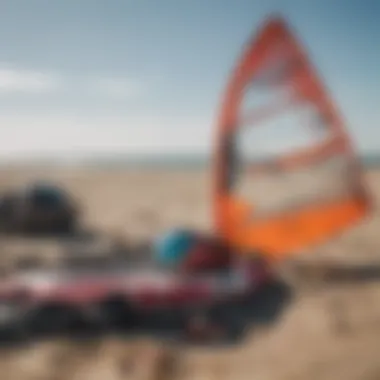

Lastly, always remember, safety is not merely about avoiding danger; it's about being proactive. Staying informed about conditions and knowing the risks can significantly enhance your kiteboarding experience on Texel. Engaging with local kiteboarding communities can provide further insights, not just into the local culture but into safe practices as well.
Local Community and Culture
The rich interplay of community and culture in Texel is what truly sets it apart as a kiteboarding haven. Here, kiteboarding isn't just a sport; it’s woven into the fabric of local life. From the interaction between residents and visitors, to the vibrant events that bring everyone together, Texel is a microcosm where kiteboarders and locals alike celebrate their love for the sea and the wind.
Kiteboarding Schools and Instructors
For anyone diving into the world of kiteboarding, having a solid foundation is key. That's where the kiteboarding schools in Texel come into play. Local instructors are not just knowledgeable about the mechanics of the sport; they know the unique conditions of Texel’s beaches like the back of their hands.
Many schools offer personalized lessons catering to various skill levels. Whether you’re a wide-eyed beginner or looking to polish your tricks, instructors here are eager to share their insights. These are some well-known schools:
- Kiteboarding School Texel
- Kite & Surf Texel
- Mellowkite Texel
What sets Texel apart is its commitment to fostering a friendly learning environment. They often host group lessons, creating camaraderie among kiteboarders while ensuring a safe and enjoyable experience. Additionally, instructors emphasize safety protocol, ensuring that every rider understands how to interpret wind conditions and react appropriately.
Events and Competitions in Texel
The kiteboarding scene in Texel is often buzzing with various events and competitions, drawing participants from not just the Netherlands but across Europe. These gatherings are not just an opportunity to showcase skills; they are a melting pot of culture, camaraderie, and community engagement.
"Competitions in Texel are not just about winning; they are about building connections and celebrating the spirit of kiteboarding.”
Key events include:
- Texel Kite Event: An annual competition that attracts kiteboarders of all skill levels. Participants vie for medals, and the community comes together to cheer on their favorites.
- freestyle competitions: These showcase the most daring tricks and stunts, where creativity meets athleticism in a thrilling display.
- Workshops and demos: Hosted regularly throughout the summer, allowing enthusiasts to learn from experts.
In essence, these events, both big and small, play a crucial role in the local culture. They not only uplift the kitesurfing community but also promote tourism and economic growth for Texel. Visitors often find themselves involved in festivities, enjoying local delicacies while soaking in the electric atmosphere.
With classes and events flowing seamlessly into community life, it’s easy to see that Texel's dedication to fostering a connected kiteboarding culture is truly commendable.
Traveling to Texel
Getting to Texel is not just about reaching a destination; it’s about embracing the journey itself. For kiteboarders and enthusiasts who have set their sights on this breathtaking island, understanding the travel logistics is fundamental. Texel, being the largest of the Dutch Wadden Islands, offers unique opportunities both on and off the water. Fleet-footed and full of vibrant energy, Texel beckons adventurers to explore its vast coastline and extensive water sport options. Therefore, discovering how to travel to Texel efficiently is key to maximizing enjoyment.
Getting There: Transportation Options
When it comes to traveling to Texel, there are a few routes that travelers can take. The island does not have a direct train connection, but it is well linked through several convenient modes of transportation.
First and foremost, many kiteboarders fly into Amsterdam Airport Schiphol, which is the closest major airport. From there, the drive to Den Helder, the mainland port from which ferries to Texel depart, can often take about an hour and a half. Alternatively, you might take public transport, using a combination of trains and buses. The train ride offers great scenery and rarely fails to impress visitors.
- Car: Renting a car could be ideal for travelers wanting flexibility to explore beyond Texel.
- Public Transport: Dutch trains are reliable. Take a train to Den Helder, and then hop on the ferry to Texel.
Upon arriving in Den Helder, the ferry is not only the most common, but it's also a thrilling way to approach the island. The crossing takes about 20 minutes and often offers stunning views of the sea, especially on clear days.
Best Accommodations for Kiteboarders
Once you've set foot on Texel, finding a comfortable place to stay close to the kiteboarding action is vital. The island has an array of accommodations well-suited for kiteboarders, whether you prefer a cozy cottage or a straightforward hotel.
- Kiteboarding Friendly Properties: Look for accommodations that cater specifically to kiteboarders. Many offer storage spaces for gear and even have workshops for minor repairs.
- Holiday Parks: Options like Roompot Park offer lodgings that are family-friendly and located near popular kiteboarding spots. These parks often feature communal amenities and recreational activities.
- B&Bs and Guesthouses: For a more intimate experience, consider local bed and breakfasts—an excellent way to meet other kiteboarders and share stories about the day’s exploits on the water.
In addition, it’s wise to book accommodations ahead of time, especially during peak kiteboarding seasons. This can ensure that you find a spot that is both convenient and meets your needs, allowing for more time spent riding the waves and less time worrying about where to rest your head at night.
"Kiteboarding in Texel is more than just a sport; it’s an adventure framed by wind, water, and wonderful communities that welcome both novices and pros alike."
From planning the journey to selecting the best accommodations, understanding how to travel to Texel sets the foundation for an unforgettable kiteboarding experience. Get to know your options and take the plunge into this kiteboarding haven.
Tips for Beginners
Kiteboarding on Texel can be a life-changing experience, especially for beginners eager to dive into the sport. These tips are geared towards making that introductory journey both safer and more enjoyable. Learning to kiteboard isn’t just about mastering the kite; it’s about understanding the environment, your equipment, and most importantly, yourself. With the right foundation, not only can one reduce the risk of accidents, but also enhance the thrill that comes with the wind in your hair and the ocean beneath your feet.
Basic Techniques to Master
Before hitting the water, there are some fundamental techniques every beginner should grasp. It’s like learning to ride a bike—you want to get comfortable before taking off downhill. Here are some core concepts:
- Kite Control: Understanding how to maneuver the kite in various wind conditions is crucial. This involves learning to steer the kite where you want it. Basic motions include pulling on the bar to lead the kite forward or back in the wind window, and tilting the kite to catch the wind efficiently.
- Body Positioning: Learning to stand properly and balance on the board is vital. Ensure your knees are slightly bent, your weight is distributed evenly over the board, and your shoulders are aligned with your hips to maintain stability.
- Water Start Technique: Focus on mastering the start from a seated position and how to use the kite’s pull to rise. Practicing this skill on land before trying it in the water can build confidence.
- Depower and Power Control: Knowing how to depower your kite, especially when gusts hit, is a skill every kiteboarder must master. This involves adjusting the bar to reduce the kite's pull without letting it fall from the sky.
"Kiteboarding is not just a sport; it’s an adventure filled with vivid sights, challenging skillsets, and a bit of wind and a lot of water!"
Common Mistakes to Avoid
Even seasoned kiteboarders make mistakes, but as a beginner, awareness of common pitfalls can keep you safe and expedite your learning process.
- Ignoring Wind Directions: Failing to check wind conditions can lead to dire situations. It’s essential to know both the wind speed and its direction relative to your position.
- Overconfidence in Equipment Mastery: Many newcomers underestimate their relation to their gear. Regular practice and understanding the nuances of your equipment play a crucial role.
- Starting Without Proper Instruction: Even with a goal to save money, trying to learn solo can lead to a lack of understanding and accidents. Find a local instructor to get personalized feedback and supervision.
- Neglecting Safety Gear: Not using the right safety gear, such as a helmet and impact vest, can result in unnecessary risks. Always prioritize your protection.
- Not Practicing Falling Techniques: Beginners might fear falling, but knowing how to fall safely can prevent injuries. Always aim to let go of the bar and roll away from your board to minimize impact.


By focusing on these basics and steering clear of common mistakes, you can set yourself up for an exciting journey in kiteboarding. Texel’s inviting waters and winds are waiting for you, and with some preparation, you're bound to make the most of your adventure!
Advanced Techniques and Tricks
Advanced techniques and tricks in kiteboarding are not just about showing off. They represent a true mastery of the sport. When kiteboarders reach a certain level, they often seek ways to enhance their rides—moving beyond the basics to more thrilling maneuvers. In Texel, with its diverse conditions and beautiful landscapes, the environment lends itself perfectly to developing these advanced skills.
The benefits of mastering advanced techniques extend beyond merely improving performance. They can boost confidence, facilitate a deeper connection with the elements, and even transform the way one interacts with the board and kite. Furthermore, these skills can lead to more dynamic experiences on the water. Riders learn to use the wind and waves to their advantage, which can lead to a higher degree of enjoyment while kiteboarding.
Freestyle Kiteboarding Skills
Freestyle is arguably one of the most exhilarating forms of kiteboarding. It focuses on jumping, spins, and flips—all while manipulating the kite to gain altitude and hang time. In Texel, kiteboarders often practice these moves during summer months when the winds are favorable.
Practicing freestyle skills involves:
- Timing and Precision: Perfecting a jump or trick requires a keen sense of timing. Riders must launch off the water at just the right moment, which involves understanding the board's speed, angle, and the kite's position.
- Body Control: It's more than just the kite; body positioning can make all the difference. Maintaining balance while in the air will determine whether the trick is successful or not.
- Practicing Safe Landings: Successful riders emphasize controlled landings. Falling from heights can lead to injuries, so it’s crucial to approach landings slowly and with intent.
Training spaces in Texel, such as De Koog beach, offer flat water areas perfect for practicing these freestyle techniques, allowing beginners to gradually build up their skills before tackling more advanced tricks.
Tips for Freestyle:
- Start with smaller jumps and progress as you feel more comfortable.
- Use the kite to generate lift; flick the kite before jumping to gain height.
- Always keep an eye on your surroundings—other riders and hazards in the water can catch you off guard.
Wave Riding Strategies
Wave riding creates a different set of challenges, requiring a nuanced understanding of the water's dynamics. Pedal to the metal isn’t always the way to ride waves; rather, it focuses on reading the water and maneuvering effectively to catch and ride the waves. On Texel's western shores, opportunities for wave riding come alive with the right wind conditions.
Key strategies for wave riding include:
- Positioning: Where you position yourself on the wave determines your ability to catch it. Riding too far back means you miss the wave, while too far forward can cause you to wipe out.
- Carving Techniques: Using bodyweight to carve into and out of waves can enhance the ride. This can create a smoother transition and allow for better use of the wave’s energy.
- Paddle Timing: Timing the kite's positioning is critical. Wait until the wave is about to break before edging out with the kite high for optimal speed.
"Wave riding is all about embracing the natural rhythm of the ocean, allowing it to guide your ride rather than forcing your way through it."
Suggestions for Wave Riding:
- Get familiar with the tides and wave patterns.
- Practice consistently in different conditions to develop a feel for the ocean.
- It helps to ride with more experienced wave riders who can share their insights and tips.
Sustainability in Kiteboarding
With kiteboarding gaining traction worldwide, the conversation around sustainability becomes increasingly significant. As more enthusiasts hit the waters, it’s important to consider the impacts this sport has on the environment and the measures being put in place to ensure its longevity. This involves protecting the ecosystems, promoting conservation practices, and creating a culture that values responsibility among kiteboarders.
Sustainability in kiteboarding is not just a buzzword; it is about adopting practices that minimize our environmental footprint while still enjoying the thrill of riding the wind. This encompasses using eco-friendly materials for gear, respecting local habitats, and promoting awareness about the ecological effects that can arise from our activities. The concept also extends to educating new kiteboarders about how their choices can influence the environment.
Environmental Initiatives on Texel
Texel, known for its pristine landscapes, has taken significant strides in promoting sustainability within the kiteboarding community. Local authorities and organizations work collaboratively to introduce programs aimed at environmental protection.
- Beach Clean-Ups: Regular beach clean-up events are organized, encouraging local kiteboarders and tourists to participate. These initiatives not only keep the shores clean but also foster a sense of community among enthusiasts.
- Kiteboarding Schools' Involvement: Many kiteboarding schools actively integrate sustainability lessons into their training programs. They teach students about local wildlife and the importance of preserving their habitats.
- Eco-Friendly Gear Promotions: Local shops often highlight eco-friendly gear, encouraging kiteboarders to choose equipment made from sustainable materials.
Texel is not just a playground for kiteboarding; it’s a place where conservation goes hand in hand with adventure. This emphasizes the message that enjoying nature does not have to come at its expense.
Promoting Eco-friendly Practices
Promoting sustainable practices is a collective responsibility. As kiteboarders, we can make simple yet impactful changes to how we engage with our environment. Here are some practices worth considering:
- Choose Eco-friendly Equipment: Brands that focus on sustainable manufacturing processes help in reducing the overall environmental impact. For instance, opting for kites made from recycled materials can significantly cut down on waste.
- Avoid Protected Areas: Be mindful of local ecological areas that require protection. Staying away from sensitive beaches or nesting sites, especially during breeding seasons, helps in preserving the local wildlife.
- Carbon Offset Initiatives: Consider participating in or contributing to carbon offset projects. This can help balance out the carbon footprint that comes with travel, gear manufacturing, and events related to kiteboarding.
"In today's world, being a responsible kiteboarder is more than just having fun; it’s about leaving a legacy for future generations to enjoy the same beauty we cherish today."
Sustainable kiteboarding is achievable if both the community and individuals commit to accountability. With Texel’s initiatives as a shining example, kiteboarders everywhere can adopt practices that not only foster enjoyment of the sport but also contribute to the preservation of our natural surroundings.
Finale: The Future of Kiteboarding in Texel
Kiteboarding on Texel stands at a pivotal point in its evolution, making this conclusion essential for understanding its prospects. As the sport grows, embracing new techniques and technologies is crucial to enhancing both the experience and safety of kiteboarders. The increasing number of participants adds a dynamic dimension to the local culture, enriching the community’s fabric while ensuring a lively atmosphere for enthusiasts.
Emerging Trends and Technologies
One cannot overlook the technological advancements that shape the future of kiteboarding. Innovations in kite design, such as lighter materials and improved aerodynamics, have transformed how riders interact with the wind. These enhancements often result in better performance and an overall exhilarating experience on the water.
- The development of smart kites, equipped with sensors to monitor wind conditions and rider performance, showcases how far innovation has come.
- Additionally, virtual training tools and apps enable riders, whether novice or seasoned, to improve their skills efficiently. With an interactive platform, they can share their experiences, advice, and tips to create a vibrant online community.
Moreover, as environmental awareness rises, eco-friendly practices are gaining traction. Many gear manufacturers are stepping up efforts to use sustainable materials and methods in their production processes. This shift not only helps the environment but also appeals to a growing demographic of conscientious travelers.
Final Thoughts on Texel as a Kiteboarding Destination
Reflecting on Texel's kiteboarding scene leads to an understanding of its vital role in nurturing this sport. The island's diverse spots accommodate various skill levels, allowing beginners to learn the ropes while advanced riders push their limits. The warm local culture and abundance of community events foster connections among kiteboarders, enhancing the overall experience.
The future looks bright for Texel, where kiteboarding continues to thrive amid evolving trends and community spirit. As kiteboarders flock to this destination, a symbiotic relationship emerges, benefiting both the thrill-seekers and local businesses alike.
In summary, Texel isn’t just a place for kiteboarding; it’s a burgeoning hub that reflects the sport’s potential. The palpable passion from those who embrace the winds of Texel only fortifies the island’s place on the global kiteboarding map, ensuring it remains a well-loved retreat for years to come.






